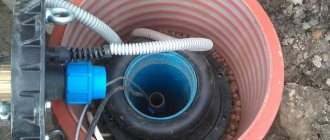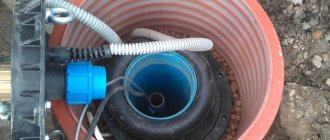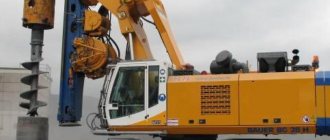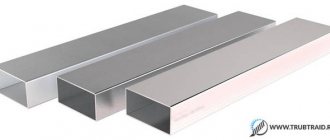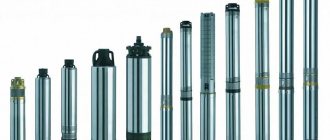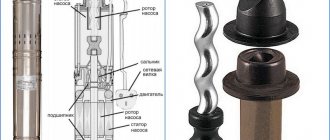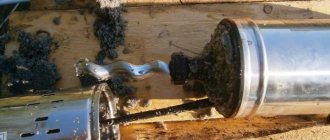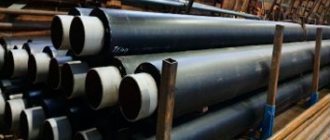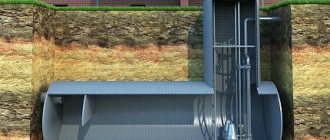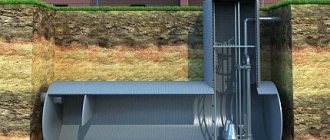Providing individual housing with water from well sources is one of the most common options in houses without access to the central water supply. When drilling, a casing pipe is taken to construct a borehole shaft, the choice of which largely determines the operational life of the source.
The trading network offers a wide range of casing pipes made of different materials with different dimensional and technical parameters. This makes it difficult to make the right decision on the optimal choice of pipes without studying information about their types and parameters.
Rice. 1 Schemes of casing columns, below is a description of the figure:
- One metal casing
- Two-pipe design with an external metal column and an internal plastic service column.
- A plastic pipe is planted to the bottom (bottom) of the well, having previously perforated it to the size of the aquifer.
- The design of a well with an intermediate casing - conductor.
- Transition to a pipe of smaller diameter with a single-pipe design.
- Double-pipe casing design.
- Transition of the production string to a smaller diameter inside the working string.
- The high casing pipe is in loose soil, and the operational plastic pipe is not protected by anything at the remaining distance.
- Single-pipe plastic column design.
Casing requirements
The answer to the question, what is a casing pipe for a well, follows from its purpose. After drilling, the well shaft needs to strengthen the walls and form a straight channel to be able to lower a deep-well electric pump into the source. To do this, a casing is formed from various types of pipes, connecting them with threads, welding, and couplings.
Basic requirements for well columns and, accordingly, pipes:
- Rigidity and strength. The depth of domestic wells when drawing water from artesian sources reaches 200 m. At such distances, the pipe walls in the bottom area experience significant soil pressure. Therefore, the pipe shell must withstand this pressure without damaging the walls or changing the cross-sectional shape.
- Sealing of joints. Since the column is assembled from pipe fragments, during installation it is necessary to ensure their tight connection. Otherwise, water will leak from the well channel outside the column. This will lead to the formation of floaters and the penetration of dirt into the mine.
- Environmentally friendly. The vast majority of domestic wells are used for drinking water supply. Pipe material should not have a harmful effect on water, changing its chemical composition.
- Chemical inertness. During its entire service life, the casing pipe is exposed to water and aggressive soil conditions. Therefore, it is important that the pipe material is chemically neutral to avoid its accelerated destruction.
- Temperature resistance. The upper section of the casing from approximately depths less than 2 m from ground level falls into the zone of influence of the external environment. Its external temperature, if we take areas with extreme climatic conditions, can vary from - 50 °C to + 40 °C. The pipe material should not change its physical and chemical properties in a given temperature range.
- Long service life. The longevity of wells directly depends on their type. If a source on sand can be operated for an average of about 5 years, then the service life of an artesian reaches up to 50 years. Therefore, it is important that the casing of the artesian source can stand without destruction of the shell throughout this period.
Rice. 2 Metal casing
Article on the topic:
Autonomous water supply for a private house - instructions for arrangement . It may be interesting to read an extended article about the organization of water supply, the equipment used, diagrams, and calculations.
Pressure or non-pressure pipeline?
The only correct option is to use pressure pipes. Only such products can withstand double-sided pressure. From the outside, the walls of the column are affected by the buoyancy of the soil, and from the inside by water pressure.
The construction of a pressure main will protect the aquifer system from premature failure. When choosing a water pipe, compare its operating pressure with the expected flow rate of the well
The video reviews below will help you decide on the most optimal well casing option.
Plastic casing pipe
The cost of polymer casing pipes is much lower than steel ones, while they are corrosion resistant and light weight. The latter advantage greatly simplifies and reduces the cost of drilling, which does not require large, heavy special equipment.
The lower strength of polymer columns does not play an important role at shallow depths and is absolutely not important when using them as additional shells inside a steel casing.
Rice. 5 Frost-resistant polypropylene - appearance of products
Related article:
How to find water on a site for a well - folk and scientific methods . It may be interesting to read an extended article about the options for drilling a well or digging a well on your own and with the involvement of water specialists.
Frost-resistant polypropylene MPP
Conventional pipe polypropylene PP is well known to owners of private houses. It is used more often than other materials to install cold and hot water supply and heating networks.
The only drawback preventing the widespread use of polypropylene outside is its low lower temperature threshold. At an ambient temperature of about -20 °C, the shell of a polypropylene pipe becomes brittle and collapses. In frost-resistant polypropylene, this drawback is eliminated by introducing elastomers into the composition - materials that can restore their shape after deformation.
Typically the fillers are synthetic ethylene propylene diene terpolymer or rubber, the additive volume is about 5%. As a result, at low temperatures polypropylene does not lose its elasticity and due to this it is possible to reduce its temperature threshold.
| The name of indicators | PPK-5 |
| Density, kg/m³ | 880 |
| Melt flow rate, MFI g/10 min (230 °C; 2.16 kg) | 5,9 |
| Heat resistance, C | 280 |
| Rubber filling | 5% |
| Lightfastness | 7-8 |
| Modulus of elasticity in bending, MPa | 300 |
| Notched Charlie impact strength at +20 °C, kJ/m² | 12 |
Table. 3 Characteristics of MPP
Frost-resistant polypropylene retains almost all the physical and chemical characteristics of the original material and has the following features:
- The lower temperature threshold that the MPP can withstand reaches – 60 °C. The upper temperature limit of MPP reaches + 140 °C, at this temperature the material softens.
- The MPP density of about 0.90 g/cm3 is the lowest among pipe polymers. As a result, the assembled column does not have excessive loads on the joints.
- The material is abrasion-resistant and elastic (this rebound indicator is 40 - 50%).
- Maximum strength index of MPP: 20 - 28 MPa.
- Elongation: 400 - 600%.
- Modulus of elasticity during bending: 300 - 1100 MPa.
- Frost-resistant polypropylene is an impact-resistant material, its impact strength before failure at temperatures of + 230 ° C is 12 kJ/m2.
- Polypropylene is chemically neutral and harmless when used in drinking water supply systems.
- The pipeline is resistant to weak acids, alkalis, oils, and salt solutions.
- Its service life reaches 50 years.
Frost-resistant polypropylene is regulated by TU 2211-065-05796653-2002 and TU 6-05-1931-82. The casing pipe made of frost-resistant polypropylene is produced in blue color.
Rice. 6 PVC-U casing pipe
Unplasticized polyvinyl chloride uPVC
Technical specifications for PVC-U pipes with threads are given in TU 2248-001-84300500-2009, some of its provisions:
- They are made in the following types: - With a socket, in which a thread is applied from the inside, and a smooth second end with an external threaded notch. — Without a socket with an increased thickness of the pipe wall and different threads at the ends.
- Thread types: trapezoidal regular TR and thrust conical TRK.
- Pipe diameter ranges from 90 to 450 mm.
- It is permissible to immerse them underground at distances of up to 100 m; a column with a thickened wall can be lowered underground to 300 m.
- PVC-U pipeline is environmentally friendly and is used in drinking water supply lines.
- The polymer is resistant to aggressive reagents and is not susceptible to corrosion processes.
- In comparison with similar plastics, the density of uPVC is higher (1.35 - 1.43 t/m3) than that of water, thanks to which the column does not float.
- Thanks to the smooth inner walls, the casing pipe has low hydraulic resistance.
- The coefficient of thermal expansion of unplasticized polyvinyl chloride is less than that of other plastics.
| Average outer diameter d | Wall thickness s | I3 thread length m. | I5 +30* length to filter | I4 +-50, mm** For effective length I2 equal | |||||
| Denomination | Deviation limit | Denomination | Deviation limit | 1000 | 2000 | 3000 | 4000 | ||
| 90 | + 0.3 | 5.0 8.0 | +0.6 +0.6 | 42 45 | 80 | 800 | 1800 | — | — |
| 113 | + 0.3 | 5.0 7.0 | + 0.7 + 0.9 | 47 | 95 | 775 | 1775 | 2775 | 3775 |
| 125 | + 0.3 | 5.0 6.0 7.5 | + 0.9 + 0.9 + 1.0 | 95 | 775 | 1775 | 2775 | 3775 | |
| 140 | + 0.4 | 6.5 8.0 10.0 | + 0.9 + 1.0 + 1.0 | 62 | 160 | 710 | 1710 | 2710 | 3710 |
| 165 | + 0.4 | 7.5 9.5 | + 1.0 + 1.2 | 170 | 700 | 1700 | 2700 | 3700 | |
| 195 | + 0.5 | 8.5 11.5 14.0 | + 1.2 + 1.8 + 1.8 | 72 | 175 | 695 | 1695 | 2695 | 3695 |
| 225 | + 0.5 | 10.0 13.0 | + 1.2 + 1.8 | 72 | 180 | 690 | 1690 | 2690 | 3690 |
| 280 | + 0.5 | 12.5 16.0 | + 1.5 + 1.0 | 88.5 | 220 | 640 | 1640 | 2640 | 3640 |
| 330 | + 0.6 | 14.5 19.0 | + 1.7 + 2.0 | 220 | 640 | 1640 | 2640 | 3640 | |
| 400 | + 0.7 | 17.5 21.5 | + 2.0 + 2.4 | 240 | 620 | 1620 | 2620 | 3620 | |
| 450 | + 0.8 | 19.5 23.5 | + 2.2 + 2.6 | 99 | 240 | 620 | 1620 | 2620 | 3620 |
Table. 4 Dimensional parameters of PVC-U pipe according to TU 2248-001-84300500-2009
- PVC-U is a dielectric material that is not subject to electrochemical corrosion and is resistant to the deposition of limescale and salts on the surface.
- They have low thermal conductivity of the order of 0.14 W/m °C.
- A distinctive feature of uPVC pipes in comparison with other materials is the lowest growth rate of bacteria on its surface.
- Neutral to aggressive chemicals used for well regeneration (hydrochloric acid).
- The melting point of PVC-U is 150 - 220 °C; when heated above 60 °C, the material softens. Becomes brittle at temperatures below -75 °C (below the glass transition threshold).
- The disadvantages of uPVC include its fragility, however, many manufacturers reduce this by adding plasticizers to the composition.
- PVC-U casing pipe has high mechanical strength and rigidity.
- The service life of uPVC is over 50 years;
- PVC-U casing pipes are cheaper than their analogues made of high-density polyethylene and polypropylene.
- UPVC pipes are produced in a light blue color; there are also cheap technical products made from recycled materials on the market, which are visually impossible to distinguish from environmentally friendly primary UPVC.
Rice. 7 HDPE casing pipe
Low pressure polyethylene (HDPE)
HDPE pipes are well known to owners of private houses that have an individual water supply installed. They are laid underground to transport water from wells and wells to housing.
GOST 18599-2001 sets technical conditions for HDPE pipes, which are distinguished by the following features:
- The casing is made from primary raw materials, which are environmentally friendly to drinking water.
- HDPE pipes have a relatively high density - over 0.941 g/cm3.
- The temperature of the transported medium for HDPE is from - 60 to + 40 °C.
- Made from PE-100 polyethylene.
- The casing is made from products with the thickest shell, so they do not have threaded sockets for connection.
- The thickness of the pipe walls is selected from the range from 6 to 10 mm.
| SDR 17 S8 | SDR 13.6 S6.3 | SDR II S3 | Ovality after extrusion, | |||||
| Middle outer | Maximum operating water pressure at 20 °C, MPa | no more | ||||||
| diameter | 1 | 1.25 | 1.6 | |||||
| Wall thickness | ||||||||
| denomination | prev off | denomination | prev off | denomination | prev off | denomination | prev off | |
| 32 | +0,3 | — | — | — | 3,0 | +0,5 | 1,3 | |
| 40 | +0,4 | — | — | 3,0 | +0,5 | 3,7 | +0,6 | 1,4 |
| 50 | +0,5 | 3,0 | +0,5 | 3,7 | +0,6 | 4,6 | +0,7 | 1,4 |
| 63 | +0,6 | 3,8 | +0,6 | 4,7 | +0,8 | 5,8 | +0,9 | 1,5 |
| 75 | +0,7 | 4,5 | +0,7 | 5,6 | +0,9 | 6,8 | +1,1 | 1,6 |
| 90 | +0,9 | 5,4 | +0,9 | 6,7 | +1,1 | 8,2 | +1,3 | 1,8 |
| 110 | +1,0 | 6,6 | +1,0 | 8,1 | +1,3 | 10,0 | +1,5 | 2,2 |
| 125 | +1,2 | 7,4 | +1,2 | 9,2 | +1,4 | 11,4 | +1,8 | 2,5 |
| 140 | +1,3 | 8,3 | +1,3 | 10,3 | +1,6 | 12,7 | +2,0 | 2,8 |
| 160 | +1,5 | 9,5 | +1,5 | 11,8 | +1,8 | 14,6 | +2,2 | 3,2 |
| 180 | +1,7 | 10,7 | +1,7 | 13,3 | +2,0 | 16,4 | +2,5 | 3,6 |
| 200 | +1,8 | 11,9 | +1,8 | 14,7 | +2,3 | 18,2 | +2,8 | 4,0 |
| 225 | +2,1 | 13,4 | +2,1 | 16,6 | +2,5 | 20,5 | +3,1 | 4,5 |
| 250 | +2,3 | 14,8 | +2,3 | 18,4 | +2,8 | 22,7 | +3,5 | 5,0 |
Table 5. Characteristics of HDPE pipes for casings made of PE-100 according to GOST 18599-2001
- They have flexibility and plasticity, which allows them not to crack when water in the pipeline becomes icy.
- Polyethylene is chemically neutral and can work for a long time in an aggressive environment.
- The service life of HDPE pipes reaches 50 years.
- They have a relatively low thermal conductivity coefficient of about 0.32 W/m °C.
- Poorly resistant to ultraviolet radiation, they are susceptible to cracking if exposed to the sun for a long time.
- Manufacturing companies sell HDPE casing pipes whose external diameters differ from the standardized digital series. Usually they are taken equal to 90, 110, 117, 120, 125, 128, 135, 140, 160 mm.
- The usual length of HDPE casing pipe is 3 or 4 m. By agreement with the customer, it can be increased.
- Since HDPE pipelines are soft and elastic, they are often used inside a casing made of high-strength metals as a second additional column.
- When a column is constructed only from HDPE pipes, its height depends on the cross-section of the walls, diameter and usually does not exceed 60 m.
- HDPE pipes are produced in black or blue colors; in the second option, they are quite difficult to distinguish from similar products made from other materials.
Rice. 8 Price list for HDPE casing pipe
High pressure polyethylene LDPE
Pipes made of high-density polyethylene (HDPE) as well as the material for their manufacture are distinguished by the following features:
- They have a density of about 0.91 g/cm3, inferior in this indicator to low-density polyethylene. Due to their lower density, they are less durable and wear-resistant than HDPE.
- They operate in a slightly wider temperature range than HDPE. Their operation is allowed in an environment from - 40 to + 90 ° C.
- They do not tolerate sudden temperature changes well.
- They have high thermal expansion.
- It has high chemical resistance even to concentrated acids and alkalis, ester-maldehyde ketones and vegetable oils.
- It contains a small amount of impurities, which has a positive effect on its environmental friendliness.
- They cost more than uPVC.
- The service life of LDPE pipes is at least 50 years.
Casing pipes made of high-density polyethylene are quite rare on the market. They have a typical blue color and are connected using external and internal socketless threads.
Rice. 9 PVD casing pipe
Fiberglass
Fiberglass pipes are so rarely seen by the average consumer that few people know what they are. In industry, they are produced by winding glass threads on a metal mandrel and simultaneously impregnating them with synthetic resins.
They are manufactured by some private enterprises using imported equipment. Fiberglass pipes are mainly used for laying pressure and non-pressure pipelines, connecting them together with couplings, flanges, sockets with sealing rings, and gluing.
The use of fiberglass pipes as elements for well casing strings is an exclusive option, which is sold by individual manufacturers represented by the Safit company.
One of the methods for manufacturing borehole fiberglass pipes is described in TU 2296-003-18057578-06; the product includes the following elements:
- fixed embedded part;
— sealing gasket;
- freely rotating castle nut.
During production, the inner layer of the pipe is covered with food grade polyethylene film, which is glued to the fiberglass shell. Pipes for wells are manufactured in full factory readiness in relation to specific projects of systems for various purposes (lifting drinking water, solutions of salts, acids, alkalis).
Rice. 10 Fiberglass casing from Safit and pipes, their characteristics
Features of fiberglass pipes:
- The area of application of fiberglass is the supply of water for domestic and drinking needs, solutions of acids, salts and alkalis.
- They can function in fire-fighting and process pipelines, in low-temperature heating networks.
- Temperature range of the working environment is from -50 to +70 °C.
- A fiberglass column weighs 4-5 times less than a steel column.
- Operational life is at least 20 years.
- The pipe is not susceptible to overgrowing with salts and biological microorganisms - fungus, mold.
- They are durable and can withstand an axial load of 25 tons. Resistant to impacts and bending.
- They are produced in a flame retardant version in accordance with GOST 12.1.044-89.
- They have a low thermal conductivity coefficient of about 0.4 W/m °C.
- They do not require the use of protection against electrochemical corrosion and do not require additional insulation.
- The company produces special adapters for standard well heads for any type of electric pump.
- Installation of a fiberglass column is fast and easy.
- Dismantling of the casing and multiple connections are allowed.
Rice. 11 Types of well sources
Rough casing
The only reason for the conscious choice of rough casing in a timber house, in my opinion, may be the desire to install a plastic window sill and plastic slopes to match it. You can only save on the type of wood. Because in all other cases, imaginary savings ultimately turn into greater costs.
A high-quality rough frame should also be made from a dry board. Unlike finishing, it does NOT select a quarter. The windows are mounted on mounting plates, just like in a stone house or an ordinary apartment. Then these plates are covered with extensions, and the end with platbands.
The option of finishing slopes with plastic additions together with a plastic window sill looks good.
Rough casing made of dry pine.
Embedding block
Unfortunately, out of ignorance, people often agree to poor-quality rough casing. It is a board with a bar nailed along it, which is placed in a groove selected in the opening. That’s why it’s called “embedded block.”
Poor quality casing
In addition to the costs of finishing the slopes, you can get hidden problems:
- will guide the board when drying, and it will pull the window along with it
- a screwed block may become bent and create a gap leading to the street
- the self-tapping screws of the fastening plates can go right through the casing and fix it to the wall of the house, thereby violating the very idea of the casing
Lumber for casing is purchased on the market. The board sizes are limited in width. This means they can stick out from the wall or be narrower than it. In this case, you will also get access to the platbands.
Casing into the embedded block 1 year after operation. The block had come off, there was little or no insulation. A gap had formed from the house to the street; it was impossible to sit near the window - it was cold!
Shuvoe.ru company specialists have repeatedly encountered reworking poor-quality rough casing - read this article https://shuvoe.ru/blog/obsada-v-zakladnoj-brusok.html
Didn't understand what was written? Want more information? in the comments and get an answer from a specialist at Shuvoe.ru LLC, a company that has been casing and finishing log buildings for more than 25 years. There are already +50 replies.Go to comments
Casing pipe - application depending on the type of well
In households, various types of wells are used for water supply, differing in the depth of penetration. In each of them, it is rational to use a certain type of casing made of metals or polymers.
Abyssinian
Abyssinian wells are shallow wells from 5 to 30 m. Water is drawn from them using a surface electric pump or station with a lowering depth of the suction pressure pipeline of no more than 8 - 9 m.
Since a deep-well electric pump is not lowered into the downhole channel, and the suction pipe of surface units has a small diameter, pipes that are small in circumference are used for casing.
Usually, a HDPE pipeline wound into coils is lowered into the Abyssinian - this allows the installation of a casing shaft without joints. Often, a small-diameter HDPE pipe of 25 or 32 mm is directly connected to an electric pump, combining the casing and suction pipe in one product.
Wells in the sand
The depth of sand wells usually ranges from 30 to 60 m.
At such distances, the pressure on the walls of the casing pipes is relatively small and polymers can be used to assemble it. For casing wells in sand, the most common pipes made of unplasticized PVC-U polyvinyl chloride, frost-resistant MPP polypropylene, and LDPE high-density polyethylene are suitable.
For significant depths of wells in sand, there are options for constructing casings from two polymer columns.
It is worth noting that manufacturers of uPVC pipes for well casing produce slotted filters with a conical plug at the end, which are the first to be immersed in the channel.
In rare situations, when the depth of a well source in sand reaches 100 m, steel casing pipes are used in the column.
Deep electric pumps of two main sizes in circumference are lowered into sand wells - 3 or 4 inches, respectively 75 - 80 and 100 mm. The diameter of the casing pipe for a polymer column is selected taking into account the size of the electric pump and the thickness of its walls; 90 is suitable for 3-inch pipes, 125 is suitable for 4-inch pipes.
Rice. 12 Scheme of casing in wells on sand and artesian wells
Artesian
The depth of the artesian springs reaches 200 m, and the column experiences significant soil loads on its shell. Therefore, there are no alternatives to high-strength steel pipes in the artesian well channel.
It is worth noting that steel corrosion, accompanied by an increase in the percentage of iron in water, is not relevant for artesian women. Most deep wells already have a high content of various metals in the aquatic environment, leading to the use of special iron removal plants for water treatment.
Often a plastic column is placed inside a steel column. This increases the corrosion resistance of the casing and increases its service life.
The second column is usually assembled from PVC-U pipes; you can also use a less durable HDPE pipeline, the load on the outer walls of which inside the steel shell is minimal.
The most common option for installing two casing strings is to place a 140-gauge steel pipe with a 125-gauge polymer pipe inside.
Rice. 13 Small-sized drilling rigs
Which column assembly option is better?
A set of requirements for casing pipes and technologies for connecting well string segments is reflected in GOST 632-80. The regulations allow the use of different assembly methods.
Based on the joining method, the appropriate type of pipe is selected, so this issue must be resolved at the well design stage.
No. 1 - permanent contact of pipes for welding
Welding provides the most rigid connection of metal pipes. The main advantage of the method is now being questioned by representatives of a number of drilling companies.
Arguments against using welding:
- the likelihood of insufficient sealing of the weld;
- the possibility of pipe deflection along the vertical axis, which makes it difficult to install the column in the well;
- insufficient corrosion protection of the seam.
However, with a high level of professionalism of the welder, the listed defects will not occur. Most building structures (bridges, trusses, oil pipelines) are made of steel and, as a rule, they are welded.
Another issue is that high-quality work requires welding equipment and the involvement of a qualified electric welder. These measures increase the cost of work performed, reducing the profit and competitiveness of the performing organization.
Welding electrodes use a protective coating, which ensures alloying of the weld seam. This increases the strength of the metal and increases the corrosion resistance of the joint.
No. 2 - water-lifting channels with threads
When casing a well with rolled metal, 90% of drilling companies use a threaded connection, pointing to GOST standards. It sounds quite convincing, but managers of organizations often keep silent that the standards are relevant for pipes with a diameter of 146 mm and a wall thickness of at least 6 mm.
The use of threaded technology significantly reduces the service life of the casing.
In a 4.5 mm thick pipe, the thread size does not always reach 1.2-1.5 mm. Knowing the rate of corrosion (0.1 mm/year), we can assume that in 12-15 years the pipe will rot at the junction
The use of a threaded connection on plastic lines does not have such disastrous consequences, but, on the contrary, is considered the most reliable.
There are several options for joining polymer pipes:
- Nipple . The thread is cut from the inside of plastic pipes. The two elements are connected through a nipple with an external thread. The diameter of the hole does not increase.
- Coupling . There is an external thread at both ends of the pipe. Docking occurs using an overhead coupling, which increases the diameter of the penetration.
- Socket threaded . Segments with threads on the outer and inner surfaces are used - joining is carried out without additional elements.
With socket joints, a slight expansion of the diameter at the joints is permissible.
The socket method of joining without threads is not used in wells - it is impossible to control the process of installing the pipe into the pipe. In addition, the connection does not provide the necessary tightness of the column and causes subsidence over time.
Downhole drilling with polymer casing
To drill the most common sand wells for water, both large-sized industrial installations and small-sized units are used. In all cases, hydraulic drilling technology is used, in which water is supplied to the borehole channel. Water supply is carried out through drill rods that are hollow inside.
Drilling wells in sand can be divided into the following stages:
Preparation. A drilling rig is placed at the work site, a water tank is brought in, and a sump pit is dug. It is necessary to implement a closed continuous cycle of water supply to the borehole channel.
That is, a groove is dug from the wellhead to a deep pit in which the water flowing out with the slurry settles. The drainage pump lifts cleaner water to the surface and sends it through pipes back into the well shaft. Drill rods are also prepared for work by lubricating their surface with machine oil.
Drilling. For penetration, drill rods of standard length 3, 4.5 or 6 m are used. A drill of the appropriate diameter and a centralizer are placed at the end of the first rod, secured in the installation mechanism and lowered into the ground, starting drilling.
Water is supplied from the tank to the drill; as soon as it begins to flow through the channel into the pit and it is filled, the dry drill mixture is poured into the water. When carrying out work, the drilling fluid performs a number of very important functions, the main of which are facilitating penetration and strengthening the channel walls. After deepening the first rod, its end is released from the grip of the installation and the second one is screwed to it. Increase the length of the drill string using rods until rock of the required composition appears in the dump and the volume of water flowing to the surface exceeds the amount injected.
Rice. 14 Drilling scheme with pits
Lowering the uPVC casing column. When water appears in the well shaft, drilling is stopped and the drill rods begin to be pulled out, disconnecting them from each other using the installation.
After removing the last rod, they begin to install the casing, the length of the pipes can be 3, 4 or 6 m. The first to be immersed in the shaft is a slotted filter, onto the end of which a conical cap is screwed. Some drillers use two or three filters instead of one. As the pipes are lowered, others are screwed to them until the length of the column reaches the required level.
Well pumping. After lowering the entire casing into the ground, the excess section of the upper pipe is cut off and the well is pumped. To do this, a rigid pressure hose is lowered into it to the filter zone and water is supplied through it using an electric pump from the tank under pressure.
To maintain strong pressure, the pipeline is connected through a sealed cap on the top pipe of the well. The water coming from the surface pump through the filter slots cleans and frees up the space behind it, washing out part of the fine soil. This will further prevent siltation of the well and increase its service life. It is worth noting that many drillers do not use an effective reverse pumping procedure, limiting themselves to pumping turbid water out of the well shaft.
After cleaning the filters with reverse flow, they begin pumping out the cloudy liquid.
A submersible pump is lowered into the borehole channel at a distance of about 0.5 m from the bottom and water begins to be pumped to the surface. The procedure takes from several hours to a day. Once clear water appears at the outlet, pumping the well is considered complete.
To prevent dirty surface water from entering the canal, a cement-sand, concrete blind area is made around the casing when it is positioned on the surface of the earth, or the top of the column is placed in a caisson well.
Related article:
How to make a filter for a well with your own hands: several options . The lower casing pipe must have a filter; it may be interesting to read what a well filter is and how to make one yourself.
Rice. 15 Drill rods and slotted uPVC filter
Purpose
When drilling wells, a casing is always made of special pipes, which performs the following functions:
- The main purpose of the casing is to protect the mine from soil shedding and clogging of the borehole channel.
- The presence of a column makes it possible for the water column to rise upward without being absorbed into the ground, and prevents water pollution.
- Due to the tightness of the connection of the pipe sections, the casing protects the well source from the penetration of contaminated surface and ground water into its channel.
- It is convenient to immerse a deep-well electric pump that sucks up water into a smooth and rigid round trunk.
- A cap or cover is attached to the top of the column, which prevents external precipitation and dirt from penetrating into the channel and serves as a support for the safety cable of the deep-well electric pump.
- When connecting an adapter water supply, the casing pipe is a support for attaching the adapter, which is cut from the side into its wall at a depth below the freezing point.
- The filter, located at the bottom of the column, filters out large and small particles of gravel, sand, limestone, clay, making the water more suitable for drinking and household needs.
Rice. 2 Designs of casing steel pipes according to GOST 632-80
How to calculate the size of openings if there are window/door sizes
Let's take as an example a 1.4 by 1.2 meter window in a house made of 150x150 profiled timber. We will calculate the width and height of the opening for a P-casing with a thickness of 90 mm. The wooden window sill is the lower part of the frame.
Calculation using the example of a window 1400 x 1200 mm.
Initial data:
- window width 1400 mm, window height 1200 mm
- thickness of side panels - 90 mm, top and window sill - 60 mm
- depth of the selected quarter for the frame - 25 mm
- drank above the tip - 70 mm
Formula:
Opening width = window width + two casing thicknesses - two quarter depths + 5 mm for the gap between the casing and the wall on each side and 10 mm for the gap between the casing and the frame, also on each side.
1400+90+90+30–50 = 1560 mm
The height of the opening = the height of the window + the thickness of the window sill + the thickness of the top + 25 mm for gaps - two quarter depths + the gap above the top.
1200+90+90+25–40+70 = 1435 mm
The principle, I think, is clear. If anything, ask in the comments.
Calculate the cost of installing windows in a turnkey log house. Send window sizes to whatsapp - click to start chat Your benefits:
- Finish casing with lifetime warranty
- Veka or Rehau windows
- Installation in 1 day (up to 7 openings)
- Painting the casing in the color of the windows
- No additional finishing work with windows is required
We work in the Moscow region and neighboring regions. Travel to other regions is possible.
Adviсe
When choosing the best casing for a well, be guided by the classic combination of price and quality. These parameters should be determined by the durability of the structure. The optimal combination can only be obtained if you choose the right type of well. There can be two options: artesian or up to the first layer.
There are many more design algorithms. It is better to make deep wells with metal parts with internal and external threads. Wells with a depth of less than 55 cm can be lined with plastic elements with the same thread.
To determine the pipe diameter, consider the following indicators:
- dimensions of the submersible pump planned for use;
- Wall thickness;
- the required minimum gap between the casing and the pump;
- In the case of using pipes with internal threads, the thickness of the nipples must also be taken into account.
The single-column casing is fixed in the ground due to natural friction. Therefore, the pipe caliber must necessarily be larger than the diameter of the penetration.
The two-column element is secured using clamps, which act as centering clamps. In this case, the annulus space must be filled with gravel or crushed stone along its entire height.
When installing a single-column casing, you should keep in mind that it is not possible to pull it back out. In a two-column scheme, the casing pipes are pulled out with a jack using a massive clamp. The silted casing can be cleaned, and the work can easily be done with your own hands with the pump pulled out.
See the next video for more details.
Drilling technology
The drilling rig is installed with your own hands only on a site prepared for work. The homemade device is installed in a small hole - a pit. It should have a depth of 2 m and dimensions of 5x1.5 m. This will prevent the collapse of loose soil, which is usually located on the surface itself. The walls of the pit are reinforced with plank boards.
A tower operating on the UKB principle is installed only on a prepared site. At the same time, the vertical installation of the main structural elements is carefully checked. The slightest curvature of the driving tool’s trajectory will make it impossible to install the casing pipe and further operate the created structure.
The destruction of the soil begins with the help of a homemade glass from a piece of pipe. Using a shock rod, it is sharply lowered to the surface from a height of 1.5 m. Using a cable with a winch, the glass is removed out and the process is repeated from the beginning. If necessary, change the driving tool to a bailer or chisel, moisten the soil or add some dry rock.
Video: Cable-percussion drilling
Selection of questions
- Mikhail, Lipetsk — What discs should I use for cutting metal?
- Ivan, Moscow - What is the GOST for rolled sheet steel?
- Maxim, Tver - Which racks for storing rolled metal products are better?
- Vladimir, Novosibirsk — What does ultrasonic processing of metals without the use of abrasives mean?
- Valery, Moscow - How to forge a knife from a bearing with your own hands?
- Stanislav, Voronezh — What equipment is used for the production of galvanized steel air ducts?
Design features of the equipment used
Impact-rope drilling of wells involves the sequential destruction of rock by crushing it. To perform the work, a Sheetz drilling rig is used. It consists of a complex of parts.
Cup. When drilling wells using the percussion-rope method, this particular tool is used, which is formed from a piece of pipe of a suitable diameter. Its end is sharpened, which improves soil cutting during operation. There may also be sharp teeth at the end of the pipe. This facilitates the process of resolving soil that is formed from wet clay or a mixture of clay and sand. As a result, the soil sticks to the walls of the glass and is removed out.
Bailer. It is a piece of pipe equipped with a valve. It allows the soil to penetrate inside, but does not let it out. This allows the well to be cleared of rock destroyed during drilling.
Bit. It is used for percussion-rope drilling of wells with your own hands, when it is necessary to destroy rocky soils.
Winch. It is installed to facilitate the lowering of the impact nozzle, which ensures the drilling process.
Frame with shock rod. It looks like a tripod. To operate effectively, the height of the structure must exceed the length by 1.5 m or more.
Cable. Provides movement of the cutting glass to the required depth. The cable is usually made of steel. It must have a diameter greater than 12 mm. This provides a sufficient margin of safety. The cable must withstand loads of non-standard magnitude that may appear during the drilling process.
Rope rope laying left and right
Device
High-quality development of the mouth has several goals:
- Easy installation of the pumping mechanism and its subsequent operation.
- Permanent access to mine shaft devices.
- Prevents dirt and impurities from entering drinking water.
- Reliable sealing of the casing pipe.
- Prevents the trunk from freezing during the cold season.
Wellhead fittings
The first is the header. It is installed directly on the casing and secured with special bolts. A rubber O-ring is placed on the outside to prevent leakage.
The second is the unloading harness. A complex element of the water supply unit from the mouth. In the upper section there are tees, ball valves, check valves, and coarse filters. All components and assemblies work in interaction with each other. The arrangement of the units depends on the number of intake devices and the volume of water consumption. Each project is calculated individually.
Third is the caisson. To protect the source from the ingress of clay, soil, and high water, as well as to prevent freezing, the equipment is covered with a caisson. This is a box made of plastic, brick, concrete or any other durable material that completely covers the casing along with all the units. The caisson can be purchased ready-made or assembled yourself.
Fourth - pump. The most important element in extracting liquid from the subsoil. The shorter the distance from the surface of the water to the pumping station, the easier it is for the impeller to draw in and direct water. That is why it is better to place the device near the head.
Fifth - equipment for automatic monitoring of problems, alarms, sensors for the proper operation of the water supply system. The automation is mounted next to the pump, which allows all components to work almost autonomously.
Scheme
A casing pipe that extends a meter out of the ground to the surface. The head is where all the equipment is hung. Submersible, cable, hose, water distribution unit. Pumping station for deep artesian mines. Electronic sensors for autonomous operation of the source. The exit is completely closed with a protective box or caisson.
Conclusions on self-installation
- Many people install the casing with their own hands. So you can too.
- Always keep in mind that you need warm openings. The window frame is not an end in itself, but an intermediate stage when installing windows and doors in a wooden house.
- Remember that a house built from timber with natural moisture shrinks by 10-15 cm per year. Leave enough free space above the top.
- The lifespan of the windows and doors of your home depends on the quality of the frame.
- If possible, avoid rough casing in the embedded block.
